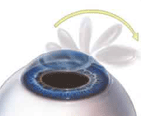Nobody is perfect. Our eyes may also not be perfect. Those who have to wear glasses or contact lenses all the time have probably dreamt at least once of not having to wear them. And actually your dream may come true with the help of LASIK eye surgery.
What is LASIK?
LASIK is an abbreviation for Laser-Assisted In Situ Keratomileusis. It is a type of surgery during which refractive errors are corrected in order to reduce a person’s dependency on contact lenses and/or glasses. The cornea — a very clear cover of the front part of an eye — is flattened permanently during the procedure with the use of excimer laser.
Understanding your eyes
The cornea and lens work together to bend, refract, the light rays so that they are focused on the retina, the inner layer of an eye, to create a clear image. Frequently the cornea has an imperfect shape and therefore refraction — bending and focusing of the light rays — is not sufficient resulting in a blurred vision and distorted image of the picture. This is called refractive errors. There are three basic types of such errors — myopia, hyperopia and astigmatism. A person, who has myopia, nearsightedness, has problems in seeing distant objects as clearly as nearby ones. A person, who has hyperopia, farsightedness, has trouble in seeing nearby objects as clearly as distant ones. Astigmatism is a type of refractive error when an eye has different focal points in different planes due to the not perfectly spherical cornea or lens. All of these errors can be and are corrected with the help of spherical and cylindrical glasses or contact lenses. Refractive errors may also be corrected during laser eye surgery, the type of which is LASIK procedure.
Lasik eye surgery
 LASIK eye surgery is an outpatient procedure. It usually takes less than 30 minutes for each eye. Local anesthesia is given with the help of local anesthetic eyedrops that numb the eye so that it becomes insensitive to the surgery.
LASIK eye surgery is an outpatient procedure. It usually takes less than 30 minutes for each eye. Local anesthesia is given with the help of local anesthetic eyedrops that numb the eye so that it becomes insensitive to the surgery.
A surgeon will place a special instrument, called a lid speculum, to keep your eyelids wide open during the procedure. After this is done, the ophthalmologist will put a ring on your cornea and use high pressures to form suction to the cornea. This will result in a cloudy vision for you at that time and is normal.
A special knife, professionally called a microkeratome, attached to the suction ring will be used to cut the outer layer of the cornea to form a flap. Then the flap will be bent back uncovering the middle layer of the cornea, also called the stroma. It is the thickest section of the cornea of an eye. The suction ring and the cutting instrument will then be removed.
You will be asked to look into the red light of the laser to create a stable position of your eye so that a doctor will be able to work on it. An ophthalmologist will then use an excimer laser in order to flatten the stroma. Pulses from the laser will be released to vaporize a certain portion of the stroma. After this has been completed, the flap will be restored to its primary position and will attach to the eyeball immediately. No stitches are needed and the procedure is over after placing a special shield over the eye in order to protect the flap. Be aware that it is very important to wear the shield all the time to avoid rubbing the eye or pressing it during sleep.
Healing is basically short but you may experience a blurred vision on the day of the laser eye surgery. Your vision should improve on the day after the procedure, however, you may still want to take a few days off after surgery.
You will not have to wear glasses or contact lenses after surgery. According to The American Academy of Ophthalmology (AAO), seven out of 10 patients achieve 20/20 vision, but 20/20 does not always mean perfect vision. And if you had LASIK performed in order to correct your distant vision you will still have to wear reading glasses from the age of about 45 due to presbyopia, the process during which the lens looses elasticity while aging resulting in a decreased ability to see nearby objects clearly.
Advantages:
- Keep the anatomy of cornea;
- Good vision is achieved very fast;
- The procedure is painless;
- Effective;
- Stability of results;
- There are no scars and seams;
- It’s possible to correct both eyes at the same time.